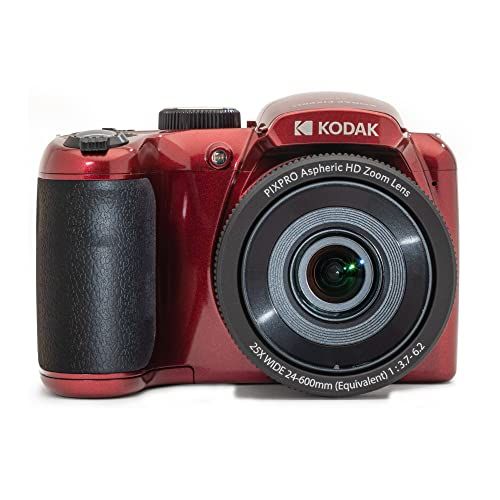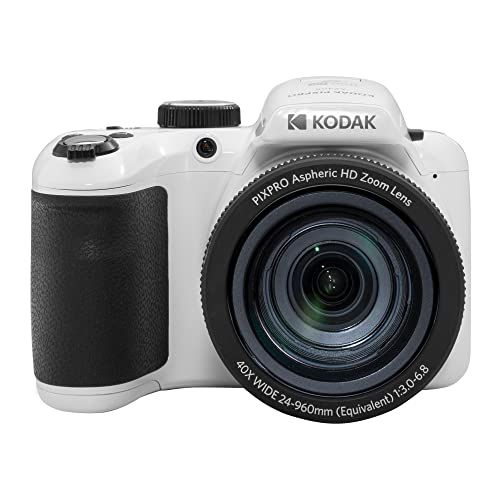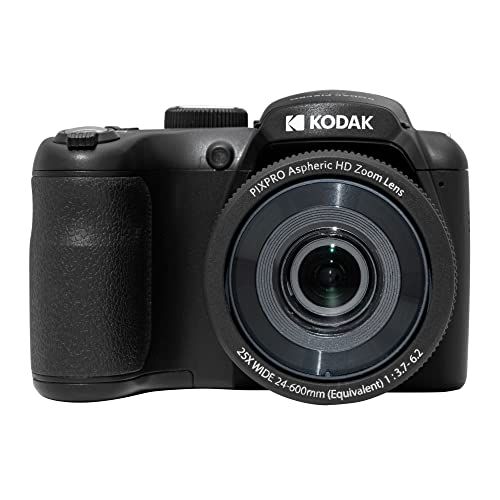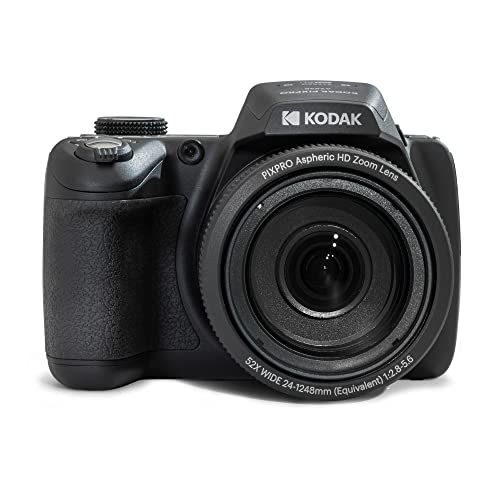Categories

Kodak has a long and storied history in photography and imaging. The company produced some of the most iconic cameras of the 20th century and played a pivotal role in making photography accessible to the masses.
Founded in 1888, Kodak was a pioneer in easy-to-use and inexpensive film cameras. Their famous Brownie camera, introduced in 1900, was inexpensive, simple to operate, and helped popularize amateur photography. Generations grew up capturing life's memories on Kodak film.
In later decades, Kodak was at the forefront of digital imaging. They produced some of the first digital cameras for consumers in the 1990s. While Kodak dominated the film camera market, the transition to digital photography proved difficult and led to the company's bankruptcy in 2012.
However, Kodak emerged from bankruptcy in 2013 and continues to produce specialty digital cameras and film. They maintain a strong reputation for image quality and user-friendly designs.
In this article, we will highlight some of Kodak's most notable film and digital camera models over the decades and examine the key features that made them popular with consumers and professionals alike.
Popular Kodak Film Cameras
Kodak has produced some of the most iconic film cameras over the years. Their easy-to-use and affordable models made photography accessible to the masses. Some of their most popular film cameras include:
Kodak Brownie Cameras - The original Brownie camera launched in 1900 and was an inexpensive, simple box camera that introduced photography to millions of people. It used 117 roll film and took 2.5-inch square images. The Brownie continued to evolve over the decades with models like the Brownie Starflash and Brownie Hawkeye that incorporated flash and multiple lens options.
Kodak Instamatic Cameras - The Instamatic series, launched in the 1960s, used drop-in cartridge film that made loading foolproof. Models like the Instamatic 100, 104, and 800 offered basic point-and-shoot operation with sharp and vibrant color images. The Instamatic was a revolutionary camera for its time.
Kodak Disposable Cameras - In the 1980s, Kodak launched disposable 35mm film cameras like the Fling, FunSaver, and Weekend that allowed anyone to take pictures then return the camera for processing. These single-use film cameras captured millions of memories and continue to have niche popularity today.
Overall, Kodak film cameras delivered good image quality in easy-to-use packages. From cartridge film to disposable models, Kodak brought photography to the masses and preserved countless moments in time. Their film cameras balanced simplicity, affordability and reliable performance.
Notable Kodak Digital Cameras
Kodak has produced several popular lines of digital cameras over the years. Two of their most well-known are the EasyShare line of point-and-shoot cameras and the more advanced PixPro bridge and mirrorless cameras.
The EasyShare line launched in 2001 and became known for its simplicity and ease of use. These compact point-and-shoot cameras were designed for beginner photographers and emphasized sharing photos. Models ranged from basic budget cameras to more advanced zoom cameras. They offered features like large LCD screens, face detection, and various scene modes.
The PixPro line debuted in 2012 and encompassed bridge superzoom cameras and mirrorless interchangeable lens cameras. These offered more manual controls, Raw shooting, and large image sensors compared to the point-and-shoot EasyShare models. Some of the most popular PixPro cameras included:
AZ521: Bridge camera with 52x optical zoom and 16MP sensor
AZ651: Bridge camera with 65x optical zoom and 20MP sensor
S-1: Mirrorless camera with 16MP Four Thirds sensor
DSC-FZ43: Bridge camera with 24x zoom and 16MP 1/2.3" BSI CMOS sensor
The PixPro models catered to more advanced photographers with their longer zooms, larger sensors for improved image quality, and increased manual control options. The AZ series became known for their ultra zoom capabilities. Overall, Kodak's digital cameras have emphasized ease of use for casual photographers while still offering options for those wanting more creative control.
Image Quality
Kodak cameras are known for producing images with vibrant, accurate colors and pleasing film grain. Kodak's proprietary film stocks like Kodak Portra and Ektar are optimized to render natural-looking skin tones and lush landscapes. The grain structure is fine and uniform, adding a filmic look without being distracting.
Kodak's digital cameras may not have the same cult following as their film counterparts, but they also produce pleasing colors and smooth tonality in JPEG images straight out of camera. While dynamic range and sharpness are not best-in-class, Kodak digital cameras have a distinctive color science that lends a pleasant warmth and brightness to photos. Images tend to look brighter and more saturated without appearing over-processed.
Whether you're shooting film or digital, Kodak cameras deliver images with a recognizable Kodak look. The colors are vibrant yet natural, the grain adds character, and there's an emphasis on brightness that flatters most subjects. While some brands aim for technical perfection, Kodak cameras have an accessible, classic rendering that makes photography fun.
Ease of Use
Kodak cameras are known for being easy to use, making them great for beginner and casual photographers. They typically have intuitive controls and user-friendly interfaces that allow you to start shooting right out of the box.
Many Kodak point-and-shoot cameras offer a range of auto modes and scene presets so you can get optimal photos in different conditions without having to manually adjust complex settings. These include landscape, portrait, nighttime, and action presets. The auto modes utilize scene detection to automatically select the ideal settings based on what you're shooting.
In-camera editing features allow you to tweak your photos without a computer. Many recent Kodak models provide filters, cropping, red-eye removal and other quick edits. Some also have built-in WiFi for wireless transfer of photos to your mobile device, where you can take advantage of mobile apps for editing and sharing your images on social media.
With their emphasis on simplicity and automation, Kodak cameras excel at making photography uncomplicated for casual users. The intuitive controls and abundance of auto features allow anyone to pick up a Kodak camera and start capturing great shots right away.
Durability and Portability
Kodak has a history of designing durable and portable cameras to withstand daily use and travel. Many of their film and digital cameras boast sturdy, compact builds that can handle accidental bumps or drops.
Several higher-end Kodak models feature weather sealing to protect the camera in rain, snow, or dusty conditions. This allows photographers to feel confident using their Kodak camera in a wide variety of locations and environments.
Battery life is another important factor for photographers on the go. Kodak's latest digital cameras use efficient image processors and sensors to provide all-day battery life, reducing the need to carry extra batteries or chargers while traveling.
The compact size and light weight of many Kodak cameras also adds to their portability. Photographers can easily pack a Kodak point-and-shoot camera in a jacket pocket or small bag for everyday outings. Even larger DSLR-style Kodak models are reasonably sized and light enough for convenient transport.
Overall, Kodak's reputation for durability and portability makes their cameras a popular choice for travel and outdoor photography. Photographers can capture high quality images without worrying about damaging their Kodak camera or running out of power while on the move.
Accessories
Kodak cameras have a good range of accessories available to help you get the most out of your photography.
Lenses
For film SLR cameras like the Kodak Retina Reflex, there are interchangeable Kodak lenses available covering a range of focal lengths. Popular lenses include wide-angle, standard, and telephoto zooms.
For non-SLR film cameras, you may be able to find some accessory conversion lenses like wide-angle or telephoto adapters.
Flashes
External flash units can help provide extra illumination when the built-in flash isn't enough. Models like the Kodak PixPro AZ651 have a hot shoe where an external flash can be mounted.
Filters
Lens filters thread onto the front of the lens to provide effects like UV reduction, color tints, polarizing, and neutral density. Check the filter thread diameter size to get the right fit.
Bags
Carrying cases and camera bags allow you to safely transport your Kodak camera and accessories. Backpack and messenger style bags are popular for holding SLR camera bodies, lenses, flashes and more during a shoot.
Straps
Neck and hand straps help keep your camera securely around your neck or wrist while shooting. Some models like the PixPro AZ651 come with a strap included.
Cleaning Kits
Sensor cleaning kits help keep your digital camera's sensor dust-free. Lens pens clean smudges off the lenses.
Batteries & Chargers
Extra batteries and external chargers ensure you don't run out of power during a shoot. Compatible options are available from Kodak and third parties.
Memory Cards
Having extra SD cards means you can shoot more photos and videos without stopping to offload. High speed cards allow faster saving/buffer clearing.
Tripods
Tripods and mini tripods provide stable support for sharper handheld-looking shots and selfies. Lightweight travel tripods are easy to carry.
So in summary, Kodak cameras have a good range of add-on accessories for lenses, flashes, bags, cleaning, power, and more.
Pros and Cons
Kodak cameras offer many benefits for photographers while also having some limitations to be aware of.
Pros
Simple and intuitive controls - Kodak cameras are designed to be easy to use for beginners. The menus and buttons are straightforward.
Good image quality - Especially for the price, Kodak cameras can produce sharp images with accurate colors. The image sensors they use perform well.
Compact size - Many Kodak point-and-shoot models are highly portable. They easily fit in your pocket.
Affordable - You can find entry-level Kodak cameras at lower price points than bigger brands. This makes them attractive for beginners.
Decent low light performance - The noise reduction capabilities in some Kodak cameras allow them to handle low light situations relatively well.
Variety of models - Kodak offers everything from simple point-and-shoots to more advanced mirrorless and DSLR cameras. There are options for all budgets.
Cons
Image noise at high ISOs - In low light scenes, Kodak cameras tend to have more image noise at higher ISO settings compared to pricier models.
Build quality feels cheaper - Some Kodak cameras have a lightweight plastic body that may not feel sturdy. Serious photographers may want something more durable.
Fewer advanced features - You won't find a huge range of bells and whistles for customization on most Kodak cameras. The features tend to be basic.
Smaller accessory system - Options for additional lenses, flashes, and other accessories are more limited than bigger brands.
Slower autofocus - For action shots, the autofocus can struggle to keep up on some Kodak models. It may not perform well for sports or kids.
No weather sealing - Most Kodak cameras lack weather sealing for protection from dust and moisture. You have to be more careful using them in rugged conditions.
Overall, Kodak cameras provide very good value for the price. While more affordable, they still deliver quality images and straightforward operation. Just be aware of some limitations around build quality, high ISO noise, and autofocus speed compared to pricier models. For many users, Kodak cameras offer an ideal entry-level solution.
Ideal Users
Kodak cameras are well-suited for casual photographers, families, and travelers who want a user-friendly and portable camera. The easy-to-use controls and point-and-shoot operation make Kodak cameras ideal for capturing vacation memories, family events, and everyday moments without having to fuss over manual settings.
The compact and durable bodies can easily slip into a pocket or bag, making them convenient for travel photography and family outings. Many Kodak cameras also offer built-in WiFi for instantly sharing photos from your camera to your smartphone.
While Kodak cameras offer excellent image quality for casual use, they may not meet the needs of professional photographers. Most lack advanced manual controls and accessories required for commercial, wedding, or fine art photography. The image quality and performance also fall short of high-end DSLR or mirrorless cameras.
However, Kodak cameras can serve as good starter or backup cameras for certain professionals like photojournalists or real estate photographers who need a compact, easy-to-use option. Overall, Kodak aims its cameras at the mainstream consumer market rather than professional photographers with specialized needs.
Conclusion
Kodak has a long and illustrious history in the photography world, dating back to the late 1800s. While the company has struggled in recent decades with the digital revolution, Kodak cameras continue to have an appeal for hobbyists and professionals alike.
The key strengths of Kodak cameras have always been their ease of use, image quality, and durability. Models like the Retina, Brownie, and Instamatic made photography accessible to the masses by being affordable and simple to operate. Even today, Kodak DSLRs and point-and-shoots are known for delivering sharp, color-accurate photos without a steep learning curve.
While smartphone cameras have taken over the mainstream market, there remains a niche for Kodak's film and digital offerings. Those looking for the classic photographic experience of analog or DSLR shooting continue to value Kodak cameras. Vintage Kodak models also have an undeniable retro charm that draws collectors and enthusiasts.
Overall, Kodak's long track record of photographic innovation and commitment to image quality cement its status as an icon of the camera world. Even as the company has had to reinvent itself, Kodak cameras old and new represent an important part of the history and advancement of photography. For those who still appreciate the tactile, hands-on experience of a dedicated camera, Kodak remains a strong choice.
Kodak Cameras comparison
 |  |  |  |  | |
|---|---|---|---|---|---|
| Model | Kodak PIXPRO FZ45 | Kodak AZ252 | Kodak Step Touch 13MP Scrapbook Bundle | Kodak PIXPRO AZ255-RD | Kodak PIXPRO AZ425 |
| Brand | KODAK | KODAK | KODAK | KODAK | KODAK |
| Model Number | FZ45BK | AZ252BK | AMZRODITC20K3B | AZ255RD | BAZ425BKSD |
| Camera Lens | - | 24 mm | - | 24 mm | 24 mm |
| Colour | Black | Black | Black | Red | Black |
| Continuous Shooting Speed | 5 fps | 3 fps | 3 fps | 30 fps | 30 fps |
| Effective Still Resolution | - | 16 MP | - | - | - |
| Focus Type | - | - | manual-and-auto | Auto Focus | Auto Focus |
| Has Image Stabilisation | Yes | Yes | - | Yes | - |
| Included Components | Camera, AA Alkaline Battery(×2), USB Cable, Wrist Strap | 1 x Camera 1 x AA Battery 1 x AC Adapter 1 x USB Cable 1 x Neck Strap 1 x Lens Cap with Cord 1 x Quick Start Guide 1 x Warranty Card 1 x Service Card | Camera Body & Accessories | Camera Body & Lens | Camera Body & Accessory |
| Item Weight | 0.26 Pounds | 0.8 Pounds | 454 g | 1 Pounds | - |
| Max Focal Length | 19.6 Millimetres | 4.3 Millimetres | - | 107.5 Millimetres | 172 Millimetres |
| Maximum Shutter Speed | 1/2000 seconds | 30 seconds | - | 1/2000 seconds | 1/2000 seconds seconds |
| Memory Slots Available | 1 | 1 | - | 1 | - |
| Min Focal Length | 4.9 Millimetres | 223.6 Millimetres | - | 4.3 Millimetres | 4.3 Millimetres |
| Minimum Shutter Speed | 30 seconds | 1/2000 seconds | 1 seconds | 30 seconds | 30 seconds seconds |
| Model Year | 2022 | 2017 | 2020 | 2022 | 2023 |
| Style | - | Camera Only | Scrapbook Bundle | - | Camera + SD Card |
| Zoom Type | Optical Zoom | Optical Zoom | Optical Zoom | Optical Zoom | Optical Zoom |
| Photo Sensor Size | 1/2.3-inch | 1/2.3-inch | - | 1/4-inch | 1/2,3 pouce |
| Model Name | PIXPRO FZ45 | AZ252 | Kodak Step Touch 13MP Digital Camera | AZ255 | BRIDGE CAMERA |
FAQ
What is Kodak?
Kodak is an American technology company that specialises in imaging solutions. It was founded by George Eastman in 1888 and has a long history in film photography. Kodak pioneered the development of roll film and made photography accessible to the mass market.
When was the first Kodak camera released?
The first Kodak camera, called the Kodak No. 1, was released in 1888. It was a simple box camera that came pre-loaded with enough film for 100 exposures. Once all the exposures were made, the entire camera was sent back to Kodak for processing and reloading. This made photography easy and affordable.
What are some iconic Kodak cameras?
Some of Kodak's most iconic cameras include the Brownie camera, released in 1900, which introduced photography to the masses. The Instamatic camera, released in 1963, was incredibly popular and used easy-load film cartridges. And the Kodak Disc camera, released in 1982, used film discs instead of rolls.
What was Kodak's role in the history of film?
Kodak played a pivotal role in the development and popularisation of consumer film. They produced easy-to-use and affordable cameras along with film in rolls and cartridges. Kodak also established processing labs and services to develop consumer photographs. At its peak, Kodak commanded 90% of film sales and 85% of camera sales in the US.
When did Kodak enter the digital photography market?
Kodak developed one of the first digital cameras in 1975, but it was not until the 1990s that Kodak began commercialising consumer digital cameras. The DC20 and DC25 launched in 1995 were early, mass-market digital cameras from Kodak.
What happened to Kodak's film business?
With the rise of digital photography in the 2000s, Kodak struggled to adapt from film photography. Despite inventing the digital camera, Kodak failed to capitalise on the new technology and finally discontinued its iconic Kodachrome colour film in 2009. Kodak eventually filed for bankruptcy in 2012 as digital photography displaced its core film business.
Is Kodak still in business today?
Yes, Kodak still exists today after emerging from bankruptcy in 2013. Kodak now focuses on digital print and advanced materials and chemicals along with brand licensing. While it no longer leads the photography industry, Kodak continues innovating in areas like print, packaging, and functional printing.
What digital cameras does Kodak make today?
Kodak currently produces a range of digital cameras for everyday photography including point-and-shoot, bridge zoom, and mirrorless cameras. Some of its latest models are the Pixpro AZ252 bridge camera, the Touch Instant Print digital camera, and the EKTRA Smartphone hybrid camera.
Where are Kodak cameras made today?
While Kodak originated in the United States, its cameras over the years have been manufactured in places like China, Taiwan, Japan and Mexico to reduce costs. Most current Kodak digital cameras appear to be produced in factories in Asia and then distributed globally.
What is Kodak's photography legacy?
Kodak is responsible for making photography accessible to the masses. Its innovative cameras, film stocks, and processing methods brought photography out of the studio and into the hands of the everyday consumer. Kodak propelled the growth of the snapshot culture and preserved countless memories in its iconic yellow boxes. Its legacy lives on today in photography and imaging.















